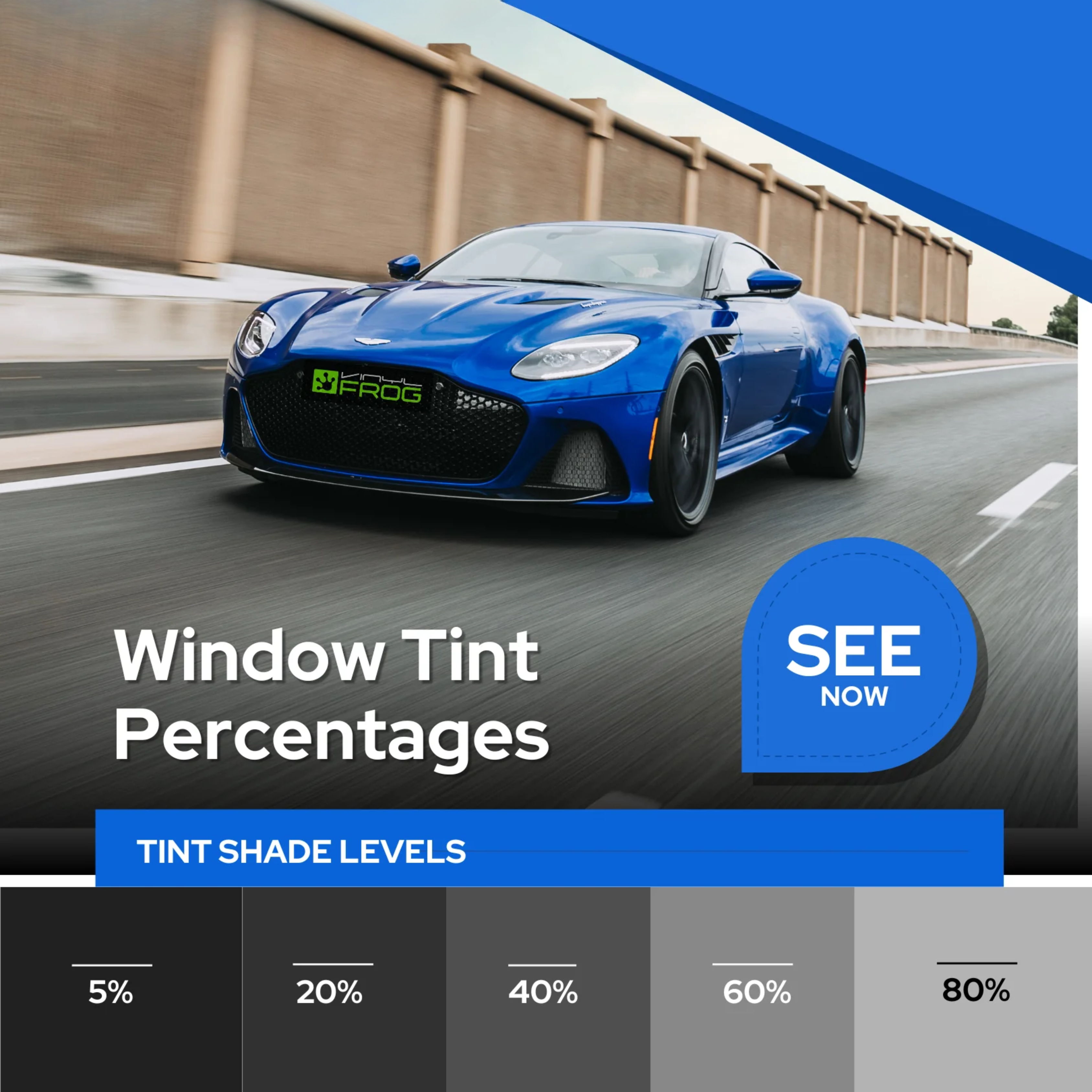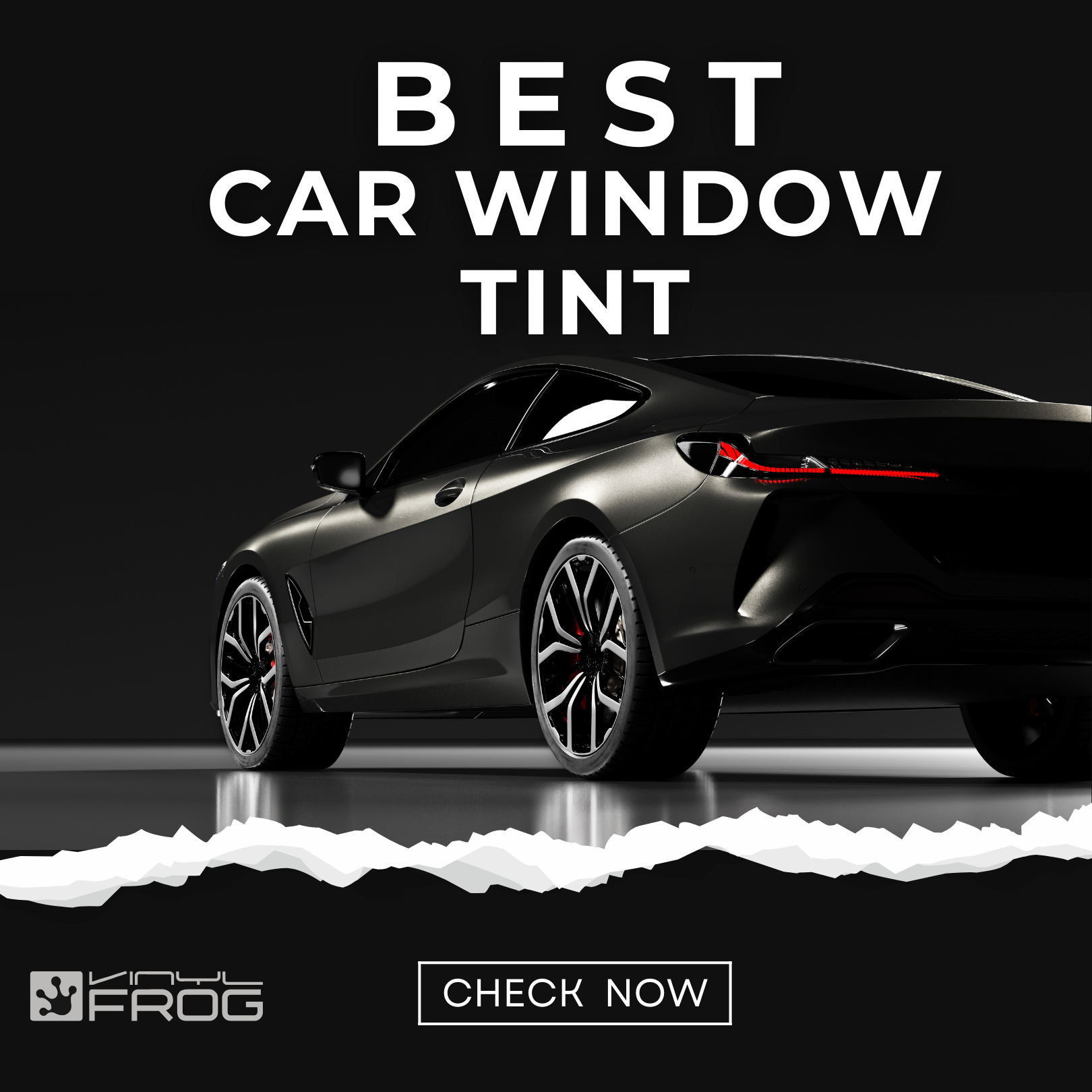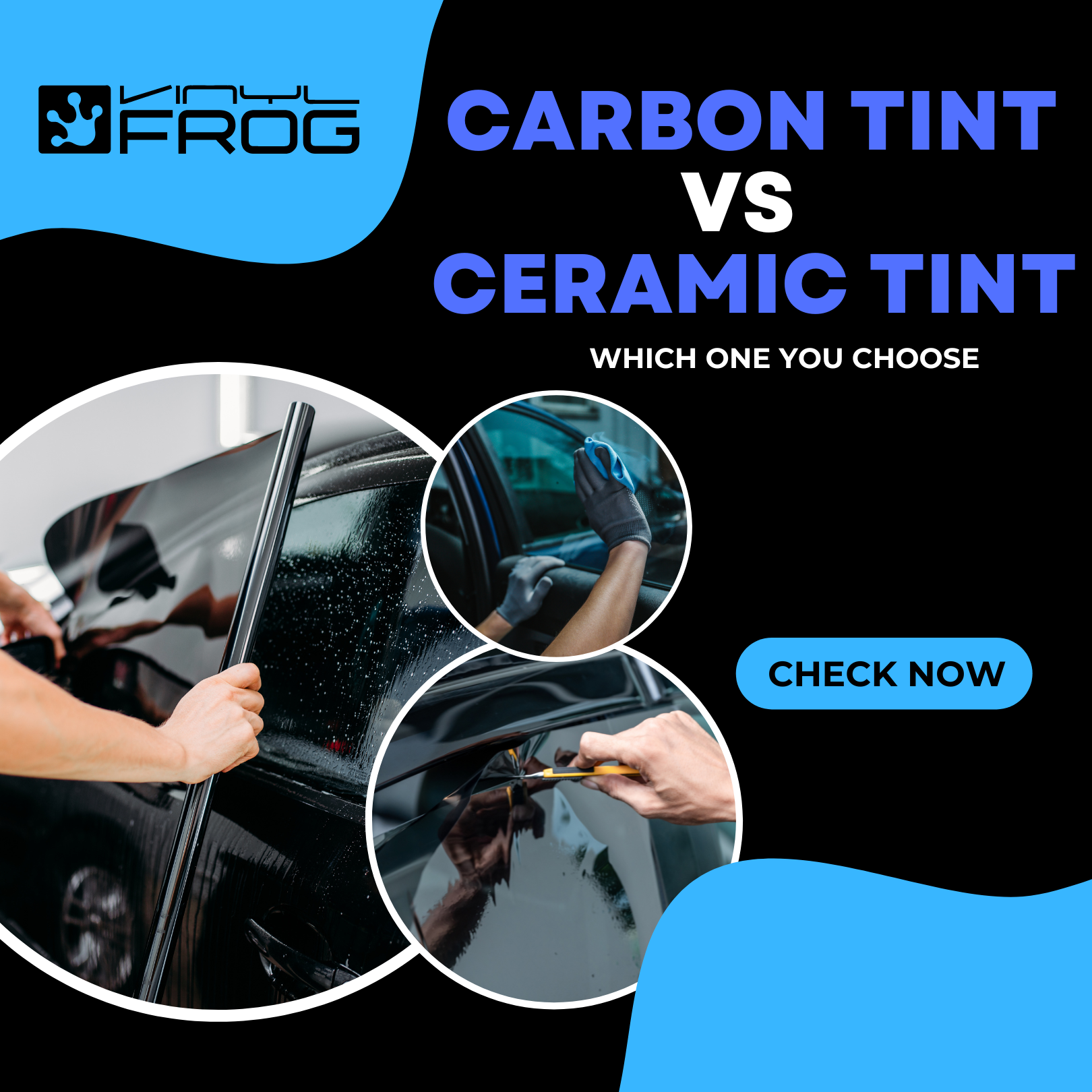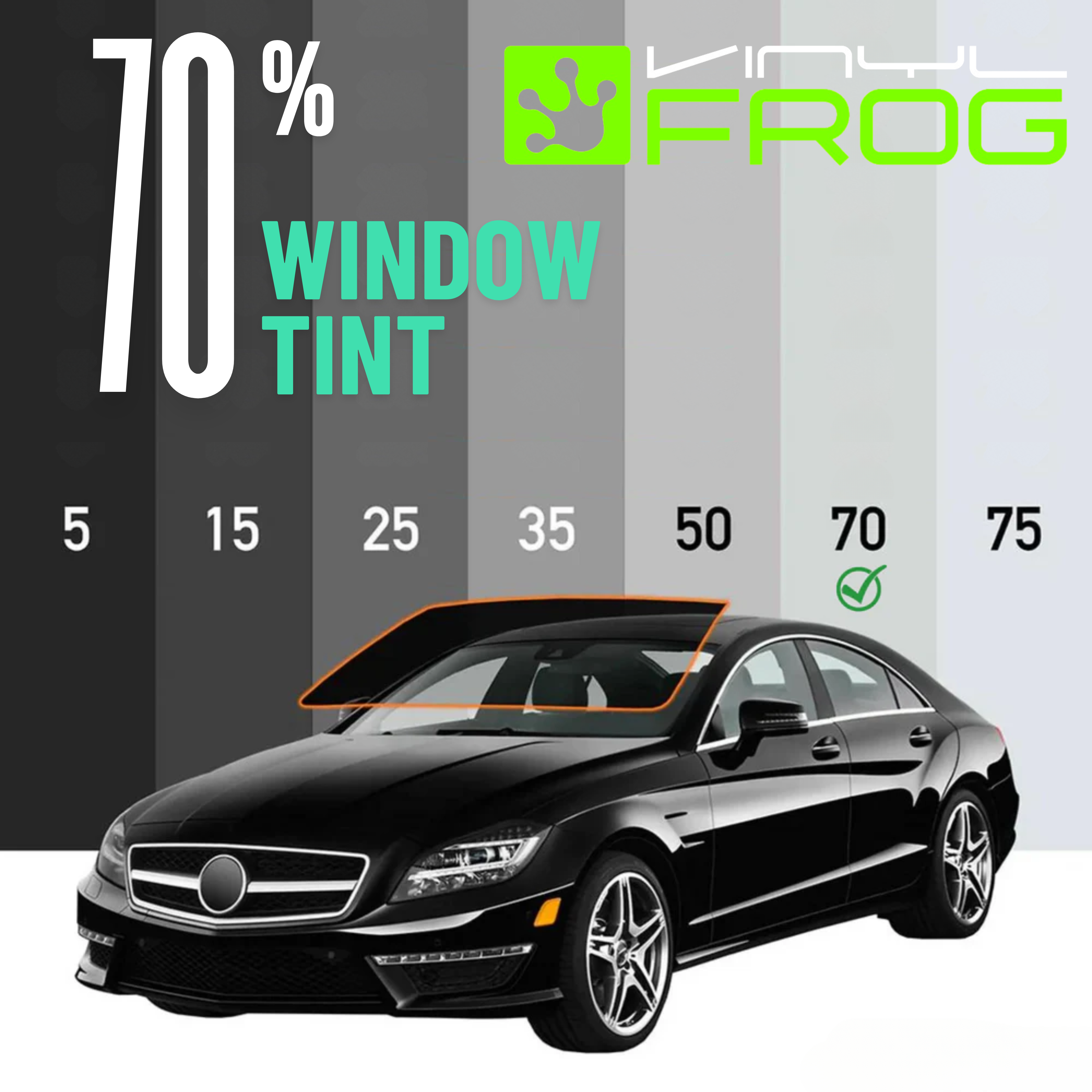Updated By Vinyl Frog On May 1, 2025
Back Window Tint - A Complete Guide

In the world of automotive customization, window tinting is a highly distinctive enhancement that is both a form of aesthetics and a functional upgrade. Back window tint is a subtle yet transformative modification that lends a touch of mystique to every drive and has gained significant popularity.
It serves a range of functional purposes, from enhancing privacy and reducing glare to mitigating the harsh impact of sunlight. As vehicles become an extension of personal style and practicality, understanding the nuances of back window tint - its types, legal regulations, and potential benefits - becomes increasingly vital for both drivers and enthusiasts alike.

In this blog, we delve into the world of back window tint for vehicles, uncovering the reasons behind its widespread adoption and the considerations essential to making informed decisions about this automotive modification.
The Benefits Of Back Window Tint
Apart from having a high aesthetic appeal, back window tint offers a multitude of benefits as well that have contributed to the growing demand for tinting among vehicle owners. These are:
Protection From The Sun
Back window tint is effective at blocking harmful ultraviolet (UV) rays from entering the vehicle. Prolonged exposure to UV rays can cause skin damage and increase the risk of skin cancer. Tinted windows provide an added layer of protection, safeguarding both passengers and the vehicle's interior from these harmful rays.
Heat Reduction And Fuel Efficiency
One of the primary benefits of back window tint is its ability to significantly reduce solar heat penetration into the vehicle's interior making it more comfortable for the passengers. By blocking a substantial portion of the sun's infrared rays, back window tint helps maintain a cooler cabin temperature, reducing the need for excessive air conditioning, especially during scorching summer months.
With less reliance on air conditioning due to the cooling effects of window tinting, vehicles can become more energy-efficient. This not only translates to potential fuel savings but also a reduced carbon footprint.
Saving The Interior Of Your Vehicle
When you invest in expensive accessories for your vehicle’s interior, you do not want them to get damaged easily. Direct sunlight can lead to the fading, cracking, and deterioration of a vehicle's upholstery, dashboard, and trim marring the luxurious look. Back window tint helps preserve the cabin’s appearance and lifespan by limiting sun-induced damage, thereby maintaining the vehicle's resale value.
If you want to which back window tint, You should buy for your car then check our blog, Best car window tint.
Ensuring Enhanced Privacy
Back window tint offers increased privacy for passengers and belongings inside the vehicle. Passersby and potential thieves are less likely to see the contents of the car, reducing the risk of break-ins. This added layer of security can provide peace of mind, especially when parked in busy or unfamiliar areas.
Reducing Eye Strain
Glare from sunlight can impair visibility and pose a safety hazard, especially during dawn and dusk. If the driver has to look through the rearview mirror before making a turn or for any other reason and is met with glare, it might be hazardous and can cause accidents. Back window tint helps minimize glare, so if need be, the driver or a passenger can see behind clearly without squinting or straining their eyes.

Preventing Windows From Shattering
Adding a tint makes the back window stronger and more resilient. It is like giving it an extra layer of armor. This additional coating helps it withstand break-in attempts and complete shattering due to collision. When windows are tinted, they are less likely to break into small pieces if something hits them. This keeps you safer by preventing dangerous shards of glass from hitting passengers during accidents.
Enhanced Beauty
Lastly, visual appeal of the back window tint is undeniable. It adds a touch of sophistication and elegance to a vehicle's exterior, enhancing its overall aesthetics. Different tint levels and styles allow vehicle owners to customize the appearance according to their preferences. A vehicle with tinted windows exudes an aura of mystery and intrigue.

In a nutshell, back window tint offers both style and practicality with its compelling advantages. Having said that it's essential to be aware of local regulations governing tint darkness and reflectivity levels. Adhering to the laws of the state ensures a safe modification that enhances your driving experience while staying compliant with traffic regulations.
Different Types Of Back Window Tint Films
There are different types of films available on the market having varying qualities, price points, and benefits. You can choose the one that best suits your needs and budget. Here’s a brief lowdown on each:
Dyed Window Tint
This is the most affordable back window tint option. It is a popular choice for enhancing the comfort and aesthetics of vehicles. This type of window film incorporates a layer of colored dye that effectively absorbs and dissipates sunlight, providing benefits such as heat reduction, glare mitigation, and protection against harmful UV rays. By filtering the incoming light, dyed window tint creates a more pleasant and cooler environment, making it particularly valuable for automobiles.
However, this tint is not long-lasting. And all the benefits that it provides as mentioned above are very limited. The tints fade over time and their ability to protect distinctly diminishes.
Metalized Window Tints
These tints contain metal microparticles and are better in performance than dyed tints. The metalized layer reflects and absorbs solar energy, offering advantages such as heat rejection, glare reduction, UV protection, and so on. It is a durable film highly resistant to scratches and wear.

The downside is that its metal content can potentially interfere with radio and GPS signals, and other electronic communications. It's important to consider this factor before installing it as a back window tint, especially in vehicles equipped with advanced communication systems.
Carbon Window Tint
Carbon window tint stands out as a premium choice for window film applications due to its exceptional performance and aesthetic appeal. Crafted using carbon particles, this type of back window tint offers an array of benefits. Notably, it effectively blocks solar heat, enhancing interior comfort by keeping vehicles cooler while also contributing to energy efficiency.
Moreover, with its sleek and matte appearance, carbon window tint adds a touch of sophistication to windows while maintaining color stability over time. Unlike metalized tints, carbon tint remains signal-friendly, allowing unhindered electronic communication. The only downside is that it is more expensive than dyed and metalized tints.
Ceramic Tint Film
Ceramic back window tint film exemplifies the pinnacle of tint technology. It is the finest tint available on the market and has non-metallic, non-conductive ceramic nanoparticles. This high level of quality offers amazing heat and glare reduction, and protection from harmful UV rays. The best part is that it does not mess with your car’s electronic signals. Ceramic film is expensive as well but its benefits are far too many.
If you want to know the difference between carbon and ceramic tint film, Then check our blog carbon Vs ceramic tint film.
Different Visible Light Transmission (VLT) Percentages for Back Window Tint
Visible Light Transmission is a measurement that indicates the amount of light that is allowed to pass through a window tint film. VLT is usually expressed as a percentage. The higher the VLT percentage, the more light is allowed to pass through the window, and the brighter the interior cabin will be. Conversely, a lower VLT percentage means less light is transmitted, resulting in a darker interior.
VLT is an important consideration when selecting the back window tint, as it affects factors such as privacy, aesthetics, heat reduction, and glare reduction. Different jurisdictions may have regulations specifying the minimum VLT allowed for vehicle windows to ensure safety and visibility for drivers and law enforcement.
For example, if a window film has a VLT rating of 30%, it means that it allows 30% of visible light to pass through while blocking the remaining 70%. This would result in a darker appearance compared to a window film with a VLT rating of 70%, which allows 70% of light to pass through and appears significantly brighter.
At Vinyl Frog, we have premium quality back window tints available in different VLT percentages such as:
5% VLT
At the forefront of darkness, the 5% VLT offers excellent privacy. It makes the car interior hard to see and protects against strong sunlight. When applied as back window tint, it serves as a perfect choice for people who want complete safety from the harmful rays of the sun and do not want prying eyes to view inside the car. This is also known as limousine tint.
20% VLT
With 20% VLT, you get a balance between privacy and visibility. It maintains its protective qualities and is a fairly dark tint. This option is good as a back window tint as it reduces glare and keeps things comfortable.
35% VLT
The 35% VLT gives a calm and balanced interior light. It does not hinder visibility while stopping the unbearable sun. Glare is reduced and the car's look stays sleek. It is also within the legal limits in most states.
50% VLT
With 50% VLT, you have more natural light inside. This option as a back window tint resonates with those who prioritize clarity of vision and a bright ambiance. While modest in its heat rejection prowess, it remains an elegant choice for many car enthusiasts.
70% VLT
This back window tint VLT percentage only blocks 30% of light, hence it is almost see-through. It lets in a lot of light and offers a gentle shield. Heat rejection is low, but it is great for those who want high visibility. This choice is often legal everywhere due to its clarity.
Whether seeking refuge behind 5% or 70% back window tint, or finding the perfect harmony in between, these films offer a spectrum of choices that redefine the driving experience.
How To Apply The Back Window Tint?
With all these advantages that you have just gone through, you might have already decided to get the back window tint. If you are planning to take the DIY route, you must first have all the necessary tools. Here’s what you will need:
- The Finest Window Tint: As we mentioned earlier, do not compromise on the quality of the window tint. Use a high-grade premium film in the VLT percentage of your choice that is according to the law in your state from the Vinyl Frog website.
- Spray Bottle with Soapy Water: Fill a spray bottle with a mixture of water and a few drops of mild soap. This will serve as the application solution, allowing you to position and adjust the film during installation.
- Squeegee: A soft rubber squeegee is essential for smoothing out the film and removing excess water and air bubbles as you apply it to the window. At Vinyl Frog, we have some of the best squeegees in different shapes and sizes for the job.
- Window Film Cutting Tool: You'll need a sharp razor blade or a specialized window film cutting tool to trim the film to fit the shape of the back window accurately. At Vinyl Frog, you get branded knives for precise cutting of the back window tint film.
- Lint-Free Cloth or Microfiber Towel: Keep a lint-free cloth or microfiber towel handy to wipe the window clean and remove excess water during the installation process. You can get a microfiber car cleaning towel from Vinyl Frog as well.
- Heat Gun: A heat gun can help you shape the window film to fit the curved surface of the back window, as well as assist in shrinking the film for a smooth finish. Get the professional heat gun from us.
- Gloves: Gloves can help prevent fingerprints and smudges on the window film during the application process. Even these are available at Vinyl Frog making it a one-stop shop for all your window tint installation needs.
- Tape: Painter's tape or masking tape can be used to secure the film in place temporarily and help create guidelines for cutting and positioning.
Remember that applying window tint requires a certain level of skill and technique. If you're not experienced in window tint installation, it might be a good idea to seek professional assistance to ensure a clean and perfect result, especially for the back window, which can be more complex due to its size and curvature.
Step-By-Step Process Of Back Window Tint Installation
- Step 1: Clean the Surface: The first and most important step is to thoroughly clean the back window, ensuring its surface is devoid of dust, debris, grease, and any contaminants. Clean the inside of the window as well. This preparation is integral to ensuring optimal adhesion of the tint film. Dry the window with a lint-free cloth.
Your workspace should also be clean and dry. You don’t want dust and dirt to contaminate the tint hindering its adhesive properties. It is better to work in a garage.
- Step 2: Remove Stickers If Any: It's important to remove any stickers and clean any residue if there is on the back window. If any of these are left behind, your film will not stick properly.
- Step 3: Cut the Film: Measure the dimensions of the back window accurately, leaving an extra inch on all sides. Carefully cut the tint film according to the measured dimensions, using the branded knife and a straight edge as a
- Step 4: Apply Soapy Water: Spritz the back window with the mild soap solution. This lubricating layer enables you to actively move the tint film during the application process, ensuring it does not stick prematurely.
Apply soapy water to the inside of the back window as well. Place the tint film on the rear window with the release liner facing up. Spray it as well so that the entire thing is covered in a thin layer of soapy
- Step 5: Apply Squeegee: Using the squeegee or credit card, gently smooth out the tint film from the center toward the edges. This action displaces air bubbles and excess water, ensuring a seamless and uniform application.
- Step 6: Apply Heat: Use a heat gun to apply heat to the film. This makes the film more pliable and fits the curvature of the window. While doing so smooth it out with a squeegee as well to remove creases if any. Apply medium heat.
- Step 7: Cut the Excess Film: With a steady hand, trim the excess tint film using the knife and the window's edge as a guide. This precision trimming ensures a clean finish that perfectly conforms to the window's dimensions.
- Step 8: Remove the Liner: Remember the film is placed in such a way that the liner is facing up. Peel the protective release liner from the tint film in sections and spritz the adhesive side with soapy water completely. Spray the inside of the window thoroughly with the solution as well.
- Step 9: Apply the Film: Carefully pick the window tint film and apply it on the inside of the rear window. Avoid the film folding on itself or getting wrinkles. Spread the tint out onto the glass. The moisture will hold it in place.
Slide the panel into position. Spray the film again, grab a squeegee, and smooth it out removing creases. Use overlapping squeegee strokes to ensure that no moisture is left underneath the window tint. Apply firm pressure.
- Step 10: Wipe Out Moisture: Wipe clean any moisture on the glass and the outside area with a lint-free cloth. Now clean the outside of the rear window as well.
- Step 11: Final Inspection: Inspect the applied tint for any remaining air bubbles or creases. If found, carefully press them outwards with the squeegee, ensuring a smooth and bubble-free surface.
- Step 12: Let the Tint Cure and Set: Allow the tint film to dry and set for at least 24 to 48 hours. During this curing period, refrain from placing any pressure on the newly applied film. After the curing period, examine the tint for any imperfections. If needed, address minor issues using the squeegee and a gentle touch.
This comprehensive process summarizes the art of applying the back window tint in the comfort of your garage. The process demands a degree of precision, patience, and attention to detail. If you are not well-versed in it, you can always get it done professionally which will result in better outcome and longevity of the back window tint.
Tips To Care For The Back Window Tint
For a perfect installation and a longer lifespan, following are some of the tips related to back window tint:
- Before you tint your rear window, check the laws in your state and others that you frequent regarding it.
- Do not apply film to frosted, etched, cracked, holed, deeply scratched, or defective glass.
- Do not apply film to Plexiglass, plastic, or acrylic windows.
- Use an ammonia-free glass cleaner to prep your rear window inside out for tinting.
- Do not use vinegar or household glass cleaners to clean glass.
- Take care of the defroster wires on the back window when installing the tint.
- To preserve the perfect condition of your back window tint, opt for mild cleaning agents and soft, lint-free microfiber cloths.
- Harsh chemicals and abrasive materials can damage the surface of the tint. Also, avoid aggressive rubbing or scrubbing instead gently dab or wipe to prevent dislodging the tint or creating unsightly marks.
- It is recommended to wait approximately 30 days before you decide on washing the back window tint.
- Opt for shaded parking spots whenever possible, as prolonged exposure to direct sunlight can accelerate wear and fading. Concealing your back window from harsh UV rays enhances the tint's longevity.
- During frosty conditions, avoid using ice scrapers on your tinted back window. Let your vehicle warm up and defrost naturally to prevent scratching or damaging the tint.
- Periodically inspect your back window tint for signs of wear, bubbling, or peeling. Early detection allows for prompt remediation, ensuring the continued elegance and potency of your tint.
- Should you wish to upgrade or repair your back window tint, entrust the task to experienced professionals. Their expertise guarantees a flawless outcome and safeguards against any inadvertent damage.
- Always abide by local laws regarding window tint darkness. Select a tint that adheres to these regulations to avoid potential legal complications.
By embracing these tips and care instructions, you can safeguard your investment, making sure that your back window tint remains an enduring testament to both style and function.
Frequently Asked Questions
Back Window Tint - The Best Customization Option!
Back window tint unveils a realm where practicality and aesthetics intertwine. It combines form and function, offering an array of benefits from heat reduction to enhanced privacy. The choice of VLT percentages, ranging from 5% to 70%, caters to diverse preferences.
Professional installation ensures optimal results and longevity while adhering to local regulations and practicing proper care safeguards your investment. For premium quality window tint films, visit Vinyl Frog today and give your back window the transformation it truly deserves!















